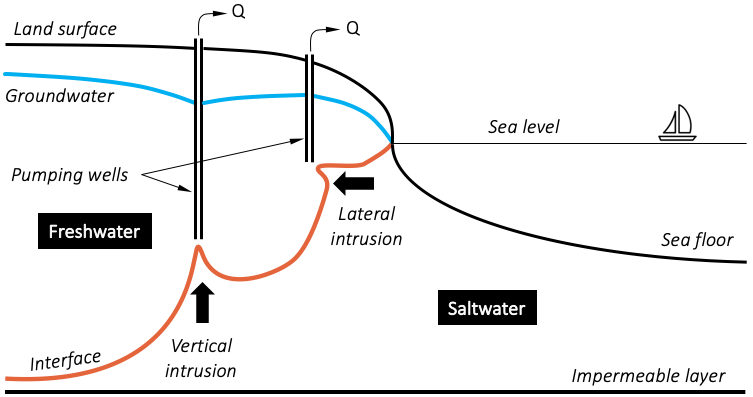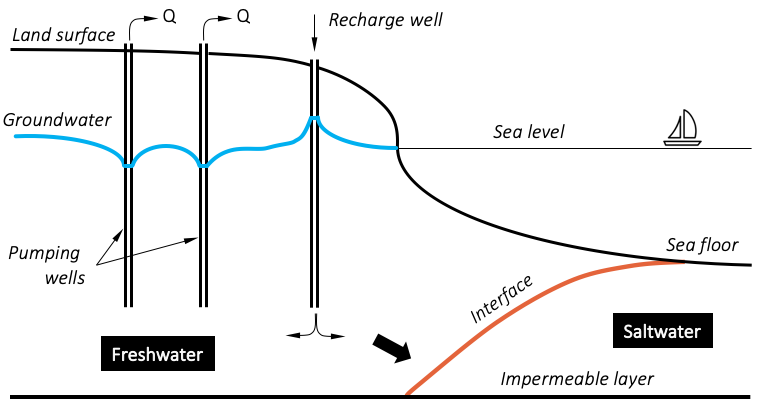The INOWAS plattform can be used to assess saltwater intrusion in coastal aquifers and the impact of Managed Aquifer Recharge (MAR) schemes to mitigate saltwater intrusion.
Saltwater intrusion is the movement of saltwater into freshwater aquifers which can cause contamination of drinking water sources. In coastal aquifers, saltwater intrusion is often occurring naturally to some extent because of the hydraulic connection between groundwater and seawater. Groundwater is often the main water source in coastal aquifers but pumping lowers the freshwater table and reduces the freshwater pressure, allowing denser saltwater to move laterally inland. Groundwater pumping can also cause upwelling or upconing of saltwater from higher depths of aquifers. Other contributors to saltwater intrusion include sea level rise and canal as well as drainage networks which provide conduits for saltwater to move inland.

Figure 1. Pumping-induced saltwater intrusion
A measure to prevent further seawater intrusion can be to recharge surplus freshwater into the coastal aquifer. This can build up a barrier against further seawater intrusion and repulse the seawater back. Many case studies have been conducted to assess the influence of MAR on saltwater intrusion. A focus has been on the impact of MAR on the extent of seawater intrusion, the recovery efficiency and the planning of new MAR facilities or the optimization of existing ones. Pauw et al., 2015 examined the impact of artificial recharge and drainage system on a freshwater lense in a reclaimed tidal flat plain in the Netherlands using the density-driven numerical flow and transport model SEAWAT. They concluded that the freshwater lense increased by MAR and more water can be extracted. Russo et al., 2015 combined GIS and modeling to identify suitable MAR sites and to assess the hydrologic impact and operating scenarios to reduce sea water intrusion in a coastal aquifer in California, USA.

Figure 2. Barrier to prevent further seawater intrusion by recharging water
The INOWAS DSS can help to evaluate the present situation and evaluate the possibility to implement MAR to stop the migration of seawater further inland. The following INOWAS tools can be used to assess the impact of MAR on the saltwater-freshwater interface as well as saltwater intrusion:
- T03. MODFLOW model setup and editor
- T07. MODFLOW model scenario manager
- T09. Simple saltwater intrusion equations
To select a suitable MAR method or a model set for the specific study area, the following tools can be used:
REFERENCES
- Pauw, P.S., van Baaren, E.S., Visser, M., de Louw, P.G.B., Essink, G.H.P.O., 2015. Increasing a freshwater lens below a creek ridge using a controlled artificial recharge and drainage system: a case study in the Netherlands. Hydrogeology Journal 23, 1415–1430. doi:10.1007/s10040-015-1264-z
- Russo, T.A., Fisher, A.T., Lockwood, B.S., 2015. Assessment of Managed Aquifer Recharge Site Suitability Using a GIS and Modeling. Groundwater 53, 389–400. doi:10.1111/gwat.12213
